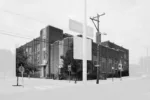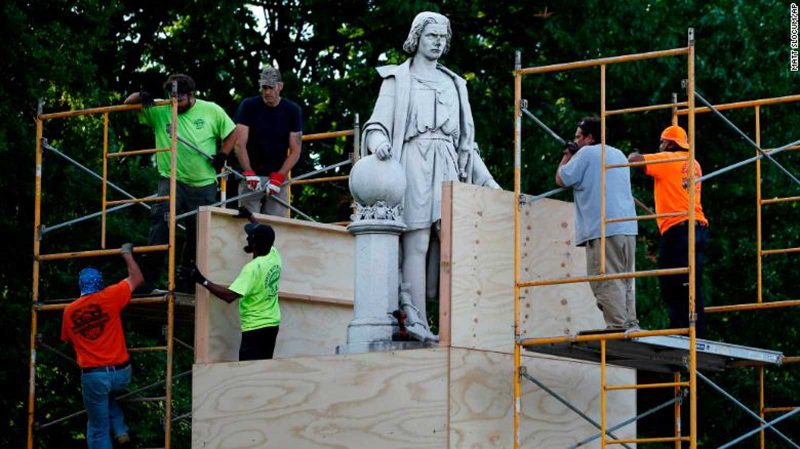
This article will cover a brief history of the Columbus statue, the South Philadelphia neighborhood, community traditions surrounding the statue and a side by side analysis of contemporary art to our own Columbus statue in hopes it opens up how public sculpture can educate and find healing. (see my analysis of Sam Durant and the Dakota 38 at the end).
It begins on Saturday June 13th when a group of around 100 people, described by a reporter [Unicorn Riot], who was accompanied by a small group of protestors on the scene, as “all-white” holding baseball bats, guns, sticks amassed to defend or rather anticipate defending the Columbus Statue in Marconi Plaza. This is not the first time the Columbus statue came under scrutiny and it will certainly not be the last. The statue next to Christopher Columbus is no saint either, Guglielmo Marconi, whom the plaza itself gets its name from was the inventor of the radio (questionably) and a fascist, like, literally.
[UPDATE: in the span of four days writing this article, protests have been ongoing, escalating in violence as some protestors were physically assaulted by statue supporters culminating in a final decision that the statue will be removed July 22nd pending approval of the Art Commission.]
The protests at Marconi Plaza stem from Black Lives Matter. An important movement which demands that, 157 years after Black people have been freed from slavery, Black lives matter. A poignant statement considering society needs the reminder. BLM lays bare the commonplace police brutality against communities of color, budgets which reflect our government’s flagrant disregard for poor, working-class people, which predominantly make up communities of color across the country. And as we watch Black Lives Matter assimilate into corporate advertisements, false institutional promises – do not mistake that Black Lives Matter stands against the capitalist system.
Tyranny seems to function in all forms of government. And tearing down statues, while symbolic, will not change a system of governing which is designed to keep working-class people in their place. As Cornel West proclaimed on CNN at the start of the mass protests we tried “Black faces in high places”, and statue discourse falls into this same trap of failing to remedy a broken system. I think the function of protests failed the Marconi (was a fascist) Plaza demonstrations, inevitably causing the city to make a rash choice to take down the statue immediately without any mediation between the opposing points of view. While protests function as; adrenaline pumping base arguments, chants, and group speak mentality, it seems protests more and more exemplify a performative radicalism that falls short in making any real change. A dance the left has been in with the right since the Civil Rights Movement.
I’d like to interrupt this scheduled article to announce, “CEOs are the most racist! All of them!” I prefer to fight them, not working-class people. At all costs I am interested in reaching across the aisle when it comes to working-class people. Having real, meaningful conversations about race is what white allyship should look like. Instead of all the talk about being a white ally posting on social media, in our echo chambers, chanting “Black Lives Matter” while calling out other white people vs. educating, virtue signaling, disowning our own families shouting, “Shame! Shame! Shame!” We all should be *out front* of Comcast exec David N. Watson’s *house*, among others. I am thankful and align with Black Lives Matter as protests, which exposed our city budgets across our nation for what they are – a mechanism to control and oppress the Black population, not lift them up.
All this said, I am obviously interested in the statue discourse because I wrote this really long article about it. My last preach to the white protestors of Marconi (was a fascist) Plaza, you should never discuss politics with a drunk person.
Throughout history statues have been torn down by society as often as they are made. Trust the process. I am ok with statues being torn down and replaced by the next statue the public deems worthy to represent the public, even if that defines the end of history like suggestions offered from numerous tweets wherein various anime figures and pop cultural icons replace historical figures. We already have a Rocky statue, so does Serbia. Statues being torn down in America symbolize a reckoning that for far too long America has ignored, across the globe in other countries too this same performance is happening. It’s as if imperialism was something we never realized shaped our continents, even as we stood in the shadow of these statues. Why are we protecting these giant assholes? Property is theft, comrades. To conquer land is to eradicate any person who does not recognize your authority, mandated by a king saying you own that land. That’s what William Penn did anyway. It’s no wonder building skyscrapers taller than his effigy was once considered an insult, “a curse”.
The international destruction of statues stems from this same imperialist lineage – a storied past consisting of oppression, genocide, slavery – colonization. Even the neighborhood Marconi (was a fascist) Plaza resides, South Philadelphia, was once named Moyamensing, the Lenape word for “pigeon droppings”. Land near the Delaware River, granted to William Penn from the Dutch West India Company, was no doubt as port for the booming slave trade offered by the new American Colonies that profitted both Europe and America. The neighborhood’s previous name (and now a street which runs diagonal across South Philadelphia) historically reads more as an appropriation rather than tribute to the Native American Lenape tribe who were native to the land before the Dutch West India Company, before William Penn, and before Christopher Columbus. The word, Lenape, literally translates to “original people”. Oral history records the Lenape first emigrated to the region from Canada 100,000 years ago. We were not taught this in school, proof school is just a means of further indoctrinating propaganda and not free thought or expression. Don’t even get me started on the university.
As the statue discourse was mounting (no pun intended) and it most certainly does every few months it seems, I’m always surprised so many Americans who devoutly want to protect statues are oblivious to how young our country is, moreover unaware of its brutal past. I’m about as surprised as seeing Bernie Sanders lose to Joe Biden. Naive, I know. I prefer idealist.
As a society, we must not approach the tearing down of statues from a black and white perspective. America does need to face its past, the statues are part of that, the symbolic gesture. I worry tearing down statues too easily quells the systemic change that needs to happen to move forward towards a more egalitarian society enabling the elite class represented in Philadelphia’s Art Commission Board to rush to tear them all down.
I would like to go into a hopefully short history of the Christopher Columbus statue in Marconi (was a fascist) Plaza in order for us all to appreciate or at the very least know what this statue represents to Italian-Americans specifically, South Philly Italian-Americans. My final point regards artistic credibility and cultural significance. The Columbus statue is considered to be by artist Emanuele Caroni, but is listed as “possible”. We are not sure who really made the statue because no one cared. The statue loses value once the artist is unknown, but then again, that is a very institutional sort of stance. Not cool or romantic at all.
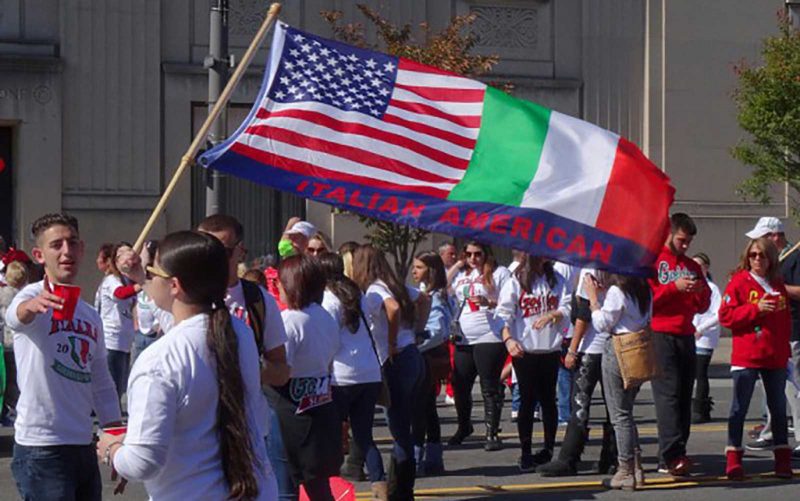
The Columbus statue was made for the Centennial Exposition (1876 duh) which took place in Philadelphia. The World’s Fairs that took place in America’s early history are like America on steroids. Columbus in a World’s Fair is as standard an American archetype as apple pie. They were expressions, challenges even, that America was, well, great – most importantly – better than everyone else. The Columbus statue for the Centennial Exposition was commissioned for Italian-Americans by Italian-Americans, namely Alonzo Viti and brothers, from South Philadelphia after hearing Columbus was born in Italy for the Centennial — an expression, a challenge even, uniting Italian-Americans as, well, great. Hire Italian-Americans! See, we are forced into these identities to get jobs. Note: America’s obsession with identity divides us. Note note: Narcissism is a function of capitalism, identity is an obsession of narcissists. This is fine. The cherry on top, Columbus was additionally celebrated as spreading Catholicism throughout the world, proof in his writings declaring “conversions of all people to the Christian faith”. The statue’s location in Fairmount Park makes for the perfect parade to South Philly taking place on Columbus Day, a pilgrimage even, Catholics love those (pilgrimages), with a mass, yesssssss. The pilgrimage, a 6 mile march, proved too far a journey from Fairmount Park, where the statue was first erected (Centennial location) and was later moved to Marconi (was a fascist) Plaza in South Philly under the direction of then Philadelphia mayor, Frank Rizzo [Italian-American-Cop], in 1976. I appreciate the ceremony. I appreciate the Catholic Church as a place for families and community to congregate in our evermore alienated culture of capitalism, but none of this is true. Christopher Columbus today arguably was not Italian or even spoke Italian by 1400’s standards, but is from the Republic of Genoa, the Northern edge which is today Italy. Columbus is more recognized as spreading smallpox across the Americas rather than Catholisim. He is widely recognized as a person who poorly governed and tortured Indigeous people. And while I have you, Italian-Americans, did you know that Italy has Universal Healthcare? Pretty coOOooOl.
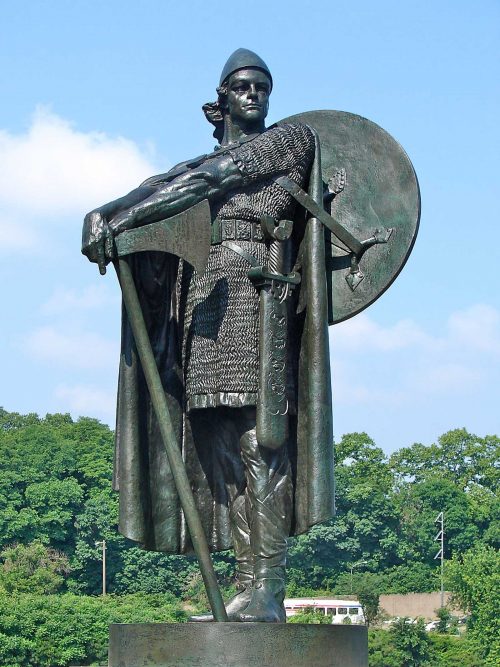
Joshua Zietz, Politico “In Germany, you won’t see neo-Nazis converging on a monument to Reinhard Heydrich or Adolf Hitler, because no such statues exist. The country long ago came to grips with the full weight of its history. But you’ll find Nazis and Klansmen in Virginia, circling a statue of Robert E. Lee, a traitor who raised arms against his own country in the defense of white supremacy.”
In 2018 Philadelphia found just that, Neo-Nazis circling the Viking statue, a statue commemorating Thorfinn Karlsefni, on the banks of the Schuylkill River (for 100 years). Later the statue was thrown in the river by activists. Both explorers, Leif Erikson and Christopher Columbus, are celebrated as discovering America. *eye roll*.
South Philly Italian-American drunkards played right into the white supremacist narrative and it is no wonder the Proud Boys began showing up in front of the Christopher Columbus statue in solidarity with the supporters of the statue. My telling, is a hopeful one, being that people are ignorantly being led, unaware they are entering white supremicsit ideology. I’m probably wrong.
Thorfinn Karlsefni is not Leif Erikson. He was an Icelandic explorer who followed Leif Erikson’s route across the Atlantic. Second place and this guy gets a statue, geeze. Um, are you confused? Symbolism, what a trip. I argue this point in contrast to the arguments for history wherein people claim a reason to keep statues standing in public. No one cares about history. I doubt you made it this far in the article illuminating historical context – briefly I might add, heh. Statues are symbolic, history is subjective and that is clearly played out in white suprememsists showing up to a Thorfinn Karlsefni statue to celebrate Leif Erikson.
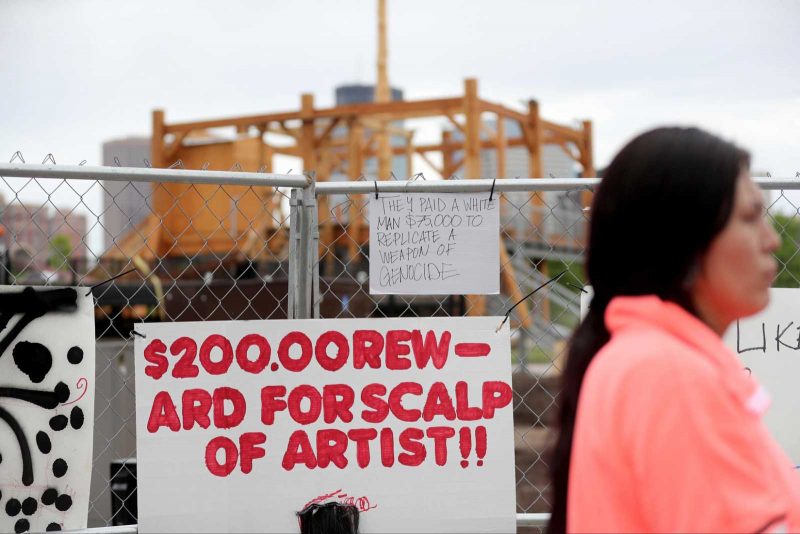
In 2017 Sam Durant, a Los Angeles artist, was paid $75,000 to install his sculpture “Scaffold,” at the Walker Arts Center sculpture garden. “Scaffold” is a replica, seven gallows, used in the U.S. in the 1800s linked to the death of abolitionist John Brown, the early labor movements and notably in context to where it stood in Minneapolis, Minn., the death of the Dakota 38, the largest mass execution in U.S. history in 1862. The Dakota 38 were part of the Native people of Minnesota caught in the aftermath of the U.S. Dakota War of 1862 whose descendants who survived were afterwards forced to march west of Minnesota – essentially a death march. The Dakota War began over land disputes, the Dakota people were forced to live on land that was not viable for survival.
Neither the artist or the Walker Art Center reached out to the local community prior to installing “Scaffold”, which immediately, as it was prominently on view in the sculpture garden, met with protests, outcrys and anger. I cannot help but wonder if the artist intended this by design as the sculpture most certainly is offensive – additionally so – as people were allowed to walk onto the structure. Later people could see children playing on the scaffold.
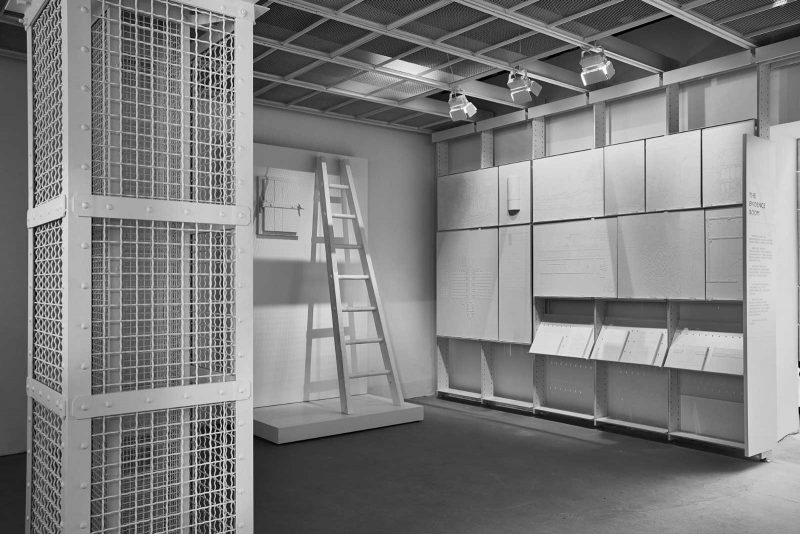
The aesthetic stark reality of “Scaffold” reminded me of Holocaust Museums which stand in nearly every city across America. Similarly there was an exhibit I saw at the Hirshhorn last summer, Evidence Room, presented by architectural historian Robert Jan van Pelt, designed by a team from the School of Architecture at the University of Waterloo in Ontario, Canada, which quite literally, exhibited plaster castings from Auschwitz as forensic architecture. The objective of the exhibition was to provide definitive proof, evidence, for Holocaust deniers – whom actually exist. Proof in the dangers of completely eradicating historical evidence of subjugation. The common thread is history laid bare to confront, make real, the past is a common practice in order to never forget. What remains to discuss is the context of these histories in relation to the communities they serve.
“Scaffold” had previously exhibited at Documenta 13 (Kassel, Germany) in 2012 without incident. It should not go without saying that Germany has a more liberal viewpoint with public sculpture than in the U.S. being that confronting government sanctioned atrocities is a prerequisite for history not repeating itself. There the “Scaffold” was not met with criticism. Sam Durant speaks well on this in an interview with Los Angeles Times:
“I think history is not about the past, it’s about the present. In that context, this country has not dealt with history at all. It’s interesting to compare it to Germany, for instance, where everywhere you go, there are monuments, memorials, markers to the Holocaust. It’s taught. It’s integral to the curriculum. It’s part of the fabric of German society: ‘Never again.'”
In the context of America, when discussing the Holocaust, its a tourist destination to…the “Memorial to the Murdered Jews of Europe” in Berlin which makes for a stylish backdrop for our Instagrams (s/o Pete Buttigieg). “Never again.” Americans very easily digest these Holocaust narratives because, like in our movies, we were the heroes. We would never. *cough* Iraq War *cough* And so in these places you will not see protests from Jewish-Americans. It didn’t happen here. Mind as well put this out there too, Jewish survivors of the Holocaust were paid reparations.

Culturally in America we have not healed from our past atrocities or even acknowledged them. The U.S. Dakota War of 1862 was not taught in school in Minnesota until 2015. History class in America reads like a cheerleading pamphlet, a World’s Fair. What’s worse is the difficult part in acknowledging our dark past, and because of such, our dark present – is left to those who are actively oppressed. What the fuck? In Minneapolis, in remembrance of the Dakota 38, the Native American community regularly performs a horse ride, some run a 90 mile marathon, from the Lower Brule Indian Reservation to Mankato where the public hanging of 38 Dakota people took place on December 26th.
Black Lives Matter is a Black movement with some white allies. I state this to say, the Native American community was already actively confronting the past and across the U.S. communities of color do this as well. Owning up to our dark past, is something predominantly white people are not doing. The death of George Floyd brought Black people to the streets to protest. From the white perspective, we are disconnected from communities of color in our segregated cities across the United States with its abysmal education system – we simply are uneducated and out-of-touch. My Catholic high school was culturally diverse, but my neighborhood was segregated. South Philadelphia is segregated. When we do join the fight it is most often for our own benefit (financially) and without acknowledging the community because simply – white people have no idea. Sam Durant is white.
These are not reasons to exclude white people or to cause derision. White people need to be in the fight. We need the numbers. Any person should act when they see injustice. Sam Durant’s inspiration was from a point of illuminating injustice. It is because Durant is making political art in the United States as a white person in a position of power through the institution, his art was going to fail, but failure makes for good art. I am hesitant to indoctrinate myself to the whims of “white privilege” hence acknowledging Durant’s race in connection to their role with the institution. Even now as I am writing this article the “thought police” are working on me questioning my white privilege, “Is it ignorant of me to write about an art piece that depicts public hangings in the same stroke of Black Lives Matter when so often American history executes Black bodies by public hangings then covers it up?” White privilege baselines us, it strips us of nuanced analytical thought.
“Scaffold” brought national attention to the U.S. Dakota War in 1862. The U.S. Dakota War is now taught in schools. The protests of the Native American community forced Minnesota to empathize. The artist met with the Dakota to decide the fate of the sculpture. They listened. They took every insult. They complied with their demands. The sculpture was dismantled by a local Native American construction crew and ceremoniously burned. The rights of the sculpture were signed over to the Dakota people and Durant agreed to never replicate the sculpture. The artist has stated they in no way felt censored. A lesson in creating public works of art especially with a political bent is that the artist does not control the outcome, but merely presents the situation and acts accordingly – barring their best ethical intentions, they act towards their best ethical outcome. Progress, afterall, stems from chaos.
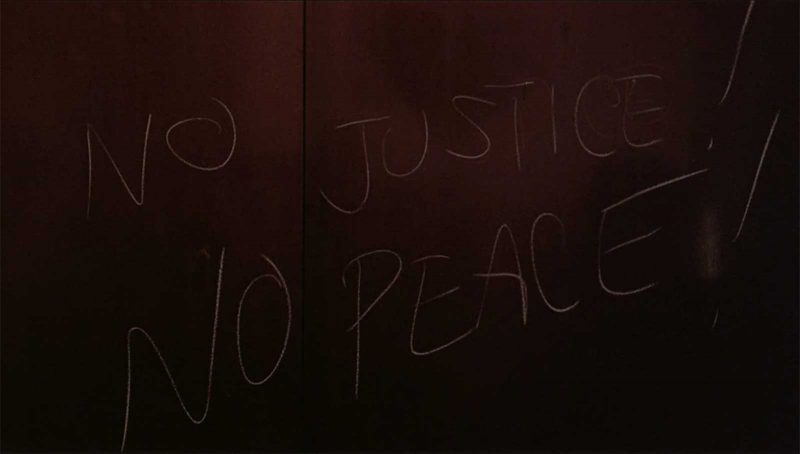
The Columbus statue is coming down. Its fate was decided through a bureaucratic process, not through a meditative ceremonial circle between the artist and the community like what happened with “Scaffold”. Because of this I have no doubt that the taking down of the Christopher Columbus statue is not an achievement. Please ignore the grounds of artist as individual versus butting communities and the role of the institution as public versus private space. Isn’t this article long enough? I want to believe that, like Sam Durant, the Italian-American community in South Philadelphia does not want to outright hurt people. The statue removal is necessary in order to avoid immediate conflict. South Philadelphia is still divided in blocks by race. At the start of this article I stated the tearing down of statues is symbolic, not always an indication of true systemic change, but we are in a Culture War. This is what the reactionaries watching Tucker Carlson are raging against, the Culture War. LAW & ORDER, Trump tweets, a racist epitaph long utilized by Republicans’ & Democrats’ campaigns to bolster fear, to divide Black and white working-class voters. White Privilege is the Democrat mantra with the same motive. So, in these, highly symbolic times, I happen to take an interest in statues. Nothing will change until there is an open discourse determined to achieve a consensus. How far will the violence escalate if we do not take this seriously and merely dismiss the hard conversations that need to be held. I guess I’m writing an article on a local artblog to call out to artists to take action. I’m hoping artists, without funding because it’s not going to happen through institutions, interested in political activism, social practice, collectives, whatever, to think about how we can creatively intervene, to think outside the protest. The ceremony still remains to be held. No Justice. No Peace.





